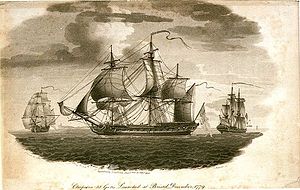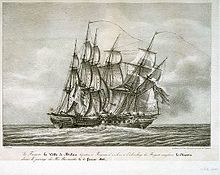
HMS Indefatigable was one of the Ardent-class 64-gun third-rate ships-of-the-line designed by Sir Thomas Slade in 1761 for the Royal Navy. She was built as a ship-of-the-line, but most of her active service took place after her conversion to a 44-gun razee frigate. She had a long career under several distinguished commanders, serving throughout the French Revolutionary Wars and the Napoleonic Wars. She took some 27 prizes, alone or in company, and the Admiralty authorised the issue of four clasps to the Naval General Service Medal in 1847 to any surviving members of her crews from the respective actions. She was broken up in 1816.
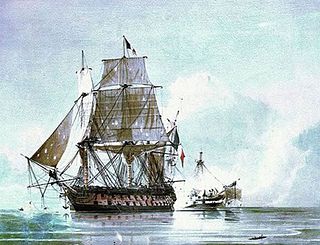
HMS Leander was a Portland-class 50-gun fourth rate of the Royal Navy, launched at Chatham on 1 July 1780. She served on the West Coast of Africa, West Indies, and the Halifax station. During the French Revolutionary Wars she participated in the Battle of the Nile before a French ship captured her. The Russians and Turks recaptured her and returned her to the Royal Navy in 1799. On 23 February 1805, while on the Halifax station, Leander captured the French frigate Ville de Milan and recaptured her prize, HMS Cleopatra. On 25 April 1805, cannon fire from Leander killed an American seaman while Leander was trying to search an American vessel off the US coast for contraband. The resulting "Leander affair" contributed to the worsening of relations between the United States and Great Britain. In 1813, the Admiralty converted Leander to a hospital ship under the name Hygeia. Hygeia was sold in 1817.
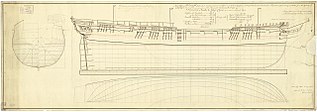
HMS Naiad was a Royal Navy fifth-rate frigate that served in the Napoleonic Wars. She was built by Hall and Co. at Limehouse on the Thames, launched in 1797, and commissioned in 1798. She served in the French Revolutionary and Napoleonic Wars, and her last actions occurred in 1824–5. She was paid off in 1826. She then served for many years in Latin America as a coal depot, first for the Royal Navy and then for the Pacific Steam Navigation Company. She was broken up in 1898, 101 years after her launching.

HMS Speedy was a 14-gun Speedy-class brig of the British Royal Navy. Built during the last years of the American War of Independence, she served with distinction during the French Revolutionary Wars.

HMS Phaeton was a 38-gun, Minerva-class fifth rate of Britain's Royal Navy. This frigate was most noted for her intrusion into Nagasaki harbour in 1808. John Smallshaw built Phaeton in Liverpool between 1780 and 1782. She participated in numerous engagements during the French Revolutionary Wars and the Napoleonic Wars during which service she captured many prizes. Francis Beaufort, inventor of the Beaufort Wind-Scale, was a lieutenant on Phaeton when he distinguished himself during a successful cutting out expedition. Phaeton sailed to the Pacific in 1805, and returned in 1812. She was finally sold on 26 March 1828.

Révolutionnaire, was a 40-gun Seine-class frigate of the French Navy, launched in May 1794. The British captured her in October 1794 and she went on to serve with the Royal Navy until she was broken up in 1822. During this service Revolutionnaire took part in numerous actions, including three for which the Admiralty would in 1847 award clasps to the Naval General Service Medal, and captured several privateers and merchant vessels.
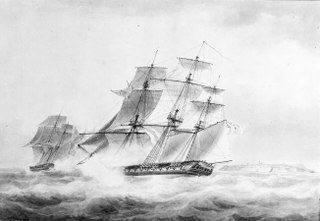
HMS Phoenix was a 36-gun Perseverance-class fifth-rate frigate of the Royal Navy. The shipbuilder George Parsons built her at Bursledon and launched her on 15 July 1783. She served in the French Revolutionary and Napoleonic Wars and was instrumental in the events leading up to the battle of Trafalgar. Phoenix was involved in several single-ship actions, the most notable occurring on 10 August 1805 when she captured the French frigate Didon, which was more heavily armed than her. She was wrecked, without loss of life, off Smyrna in 1816.
USS Herald was a full-rigged ship of about 270 tons burthen built in 1797 at Newburyport, Massachusetts. The US Navy purchased her on 15 June 1798, and sold her in 1801. She became the French 20-gun privateer corvette Africaine. In 1804 a British privateer seized her on 4 May 1804 off the coast, near Charleston, South Carolina. The seizure gave rise to a case in the U.S. courts that defined the limits of U.S. territorial waters. The U.S. courts ruled that the privateer had seized Africaine outside U.S. jurisdiction. Africaine then became a Liverpool-based slave ship that made two voyages carrying slaves from West Africa to the West Indies. After the abolition of the slave trade in 1807 she became a West Indiaman that two French privateers captured in late 1807 or early 1808.

HMS Druid was a 32-gun Hermione-class fifth-rate frigate of the British Royal Navy, launched in 1783 at Bristol. She served in the French Revolutionary Wars and the Napoleonic Wars, capturing numerous small prizes. One of her commanders, Captain Philip Broke, described Druid as a "point of honour ship", i.e., a ship too large to run but too small to fight. He and his biographer's view was that it was a disgrace to use a ship like her as a warship. She was broken up in 1813, after a thirty-year career.

HMS Milan was a 38-gun fifth rate frigate of the Royal Navy. She had previously been Ville de Milan, a 40-gun frigate of the French Navy, but served for only a year before being chased down and engaged by the smaller 32-gun frigate HMS Cleopatra. Ville de Milan defeated and captured her opponent, but suffered so much damage that she was forced to surrender without a fight several days later when both ships encountered HMS Leander, a British fourth rate. Milan went on to serve with the Royal Navy for another ten years, before being broken up in 1815, after the conclusion of the Napoleonic Wars.
Admiral Sir Robert Laurie, 6th Baronet KCB was an officer of the Royal Navy who served during the French Revolutionary and Napoleonic Wars. He rose through the ranks after his entry, fighting as a lieutenant under Howe at the Glorious First of June, and being wounded in the action. Shortly after he served in the West Indies and off the American coast, where he operated successfully against enemy raiders and privateers, he was rewarded with the command of the frigate HMS Cleopatra, and in 1805 fought an action with a superior French opponent, Ville de Milan. He was forced to surrender his ship after several hours of fighting, but so heavily damaged the Frenchman that both she and the captured British vessel were taken shortly afterwards when another British frigate HMS Leander, arrived on the scene. Rewarded for his valour and honourably acquitted for the loss of his ship, he served throughout the rest of the Napoleonic Wars. He rose to flag rank after the end of the wars, eventually dying in 1848 with the rank of Admiral of the White. He inherited a baronetcy in 1804, but this became extinct upon his death.
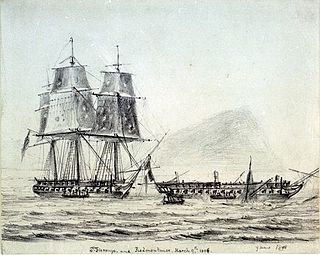
Minerve was a 40-gun frigate of the French Navy, lead ship of her class. She operated in the Mediterranean during the French Revolutionary Wars. Her crew scuttled her at Saint-Florent to avoid capture when the British invaded Corsica in 1794, but the British managed to raise her and recommissioned her in the Royal Navy as the 38-gun fifth rate HMS St Fiorenzo.

HMS Lynx was a 16-gun ship-rigged sloop of the Cormorant class in the Royal Navy, launched in 1794 at Gravesend. In 1795 she was the cause of an international incident when she fired on USRC Eagle. She was at the Battle of Copenhagen in 1801, and during the French Revolutionary and Napoleonic Wars took numerous prizes, mostly merchant vessels but also including some privateers. She was also at the second Battle of Copenhagen in 1807. She was sold in April 1813. She then became the whaler Recovery. She made 12 whaling voyages in the southern whale fishery, the last one ending in 1843, at which time her owner had her broken up.
His Majesty's Hired armed lugger Duke of York served the Royal Navy from 14 October 1794 to 2 January 1799 when she foundered in the North Sea.

Gracieuse was a 32-gun Charmante-class frigate of the French Navy. Renamed to Unité in 1793, she took part in the French Revolutionary Wars. The Royal Navy captured her in 1796 off Île d'Yeu and brought her into British service as HMS Unite. She was sold in 1802

HMS Lapwing was a 28-gun Enterprise-class sixth-rate frigate of the Royal Navy.

HMS Nymphe was a fifth-rate frigate of the British Royal Navy, formerly the French Nymphe, lead ship of her class. HMS Flora, under the command of Captain William Peere Williams, captured Nymphe off Ushant on 10 August 1780. Indiscriminately referred to as Nymph, Nymphe, La Nymph or La Nymphe in contemporary British sources, she served during the American, French Revolutionary and Napoleonic Wars. On 19 May 1793, while under the command of Captain Edward Pellew, she captured the frigate Cléopâtre, the first French warship captured in a single-ship action of the war. After a long period of service in which she took part in several notable actions and made many captures, Nymphe was wrecked off the coast of Scotland on 18 December 1810.
Jean-Marie Renaud was a French Navy officer. He is mainly known as the commander at the action of 22 October 1794.
HMS Stag was a 32-gun fifth-rate frigate built for the Royal Navy. She was ordered in 1790 and work began in March 1792 at Chatham Docks. Completed in August 1794, Stag spent much of her service in home waters, where she worked to protect British shipping from French privateers. In an action on 22 August 1795, Stag engaged, and forced the surrender of, the Dutch frigate Alliante, and took part in the chase that ended with the capture of Bonne Citoyenne by HMS Phaeton on 10 March 1796.

HMS Caroline was a 36-gun fifth-rate Phoebe-class frigate of the Royal Navy. She was designed by Sir John Henslow and launched in 1795 at Rotherhithe by John Randall. Caroline was a lengthened copy of HMS Inconstant with improved speed but more instability. The frigate was commissioned in July 1795 under Captain William Luke to serve in the North Sea Fleet of Admiral Adam Duncan. Caroline spent less than a year in the North Sea before being transferred to the Lisbon Station. Here she was tasked to hunt down or interdict French shipping while protecting British merchant ships, with service taking her from off Lisbon to Cadiz and into the Mediterranean Sea. In 1799 the ship assisted in the tracking of the French fleet of Admiral Étienne Eustache Bruix, and in 1800 she participated in the blockade of Cadiz.
